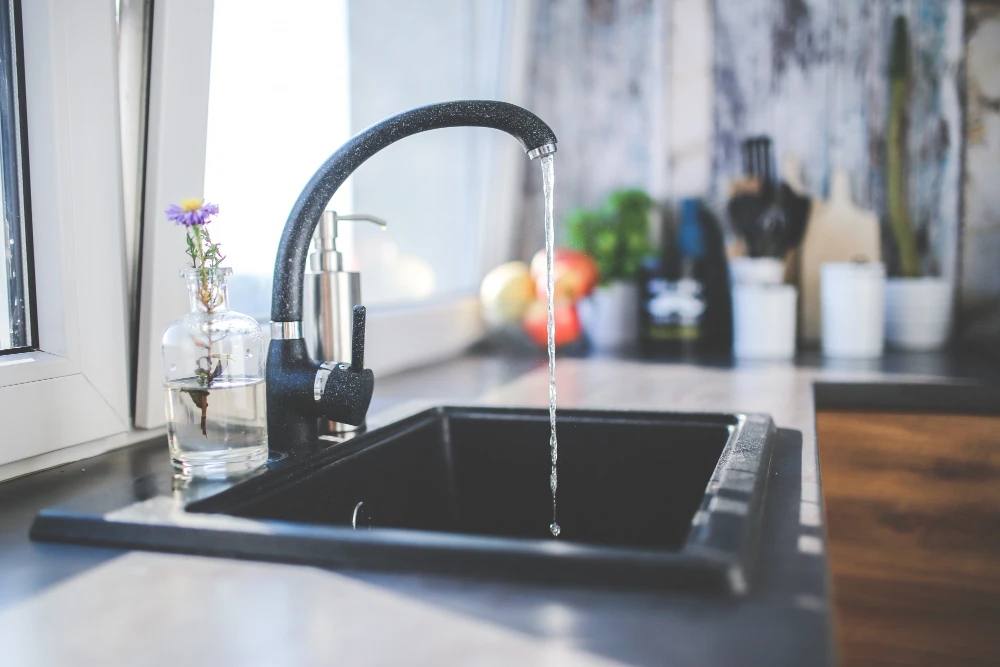Overview
There’s nothing more frustrating than turning on your kitchen faucet only to be met with a weak stream of water. Whether you’re washing dishes or filling a pot, low water pressure can make everyday tasks take longer and feel more tedious. So, why is the water pressure low in your kitchen sink, and what can you do about it?
In this guide, we’ll explore the most common causes behind low water pressure, how to diagnose the problem, and the best plumbing solutions to restore strong, consistent flow. Let’s dive in.
Key Takeaways:
- Low water pressure in the kitchen sink often stems from simple, fixable issues.
- Troubleshooting steps can help identify whether the problem is localized or systemic.
- Timely plumbing maintenance can prevent pressure issues from worsening.
Common Causes of Low Water Pressure in Kitchen Sinks
Low water pressure is often the result of a specific problem that either restricts the flow of water or reduces the pressure reaching your kitchen sink. Understanding these causes can help you determine the right course of action.
Clogged Aerator
An aerator is the small mesh screen located at the end of the faucet spout. Its job is to mix air with the water stream, which helps reduce splashing and conserve water. However, because it acts as a filter of sorts, it can easily become clogged over time.
Why it happens:
- Hard water contains minerals like calcium and magnesium that can build up on the aerator screen.
- Sediment and debris from old pipes or the water supply line can also get trapped.
Signs of a clogged aerator include:
- A noticeably weaker stream of water
- Uneven spray patterns
- Sputtering or spitting water
- Temporary improvement in pressure when the aerator is removed
Blocked or Damaged Plumbing Pipes
Beyond the faucet itself, the water supply lines running to your kitchen may be partially blocked or deteriorating. Over time, especially in older homes, piping materials like galvanized steel can corrode or collect buildup on the interior walls.
Common pipe-related issues include:
- Mineral buildup inside the pipes from hard water, which gradually narrows the pipe diameter
- Corrosion in aging galvanized or iron pipes, which causes internal scaling and rust
- Sediment from the water supply that settles and forms clogs in low-use sections of pipe
Impact of damaged or blocked pipes:
- Reduced water pressure at one or more fixturesLeaks caused by cracks or pinholes in corroded pipes
- Water discoloration due to rust
- Potential water damage in hidden areas like behind cabinets or under floors
In severe cases, pipe replacement may be necessary. Copper or PEX piping offers a longer lifespan and better resistance to corrosion compared to older galvanized steel.
Issues with the Water Supply
Sometimes, the issue lies outside your plumbing system. Water pressure from the municipal supply can fluctuate due to demand, maintenance, or malfunctions in the water main.
Municipal water supply problems may be caused by:
- Scheduled maintenance or upgrades to city lines
- Hydrant flushing that temporarily changes pressure levels
- High demand during peak usage hours like early morning or evening
- Undetected leaks or broken mains that reduce supply pressure
To verify if this is the cause, ask neighbors if they’re experiencing similar issues. If so, it’s likely not a problem with your plumbing. Contact your water utility provider for information. You can also check your home’s water meter for signs of leaks by ensuring no water is running, then observing the meter for movement.
How To Diagnose the Problem?
Pinpointing the exact reason behind your kitchen sink’s low water pressure requires a careful, step-by-step process. By systematically ruling out causes, you can avoid unnecessary repairs and target the real issue.
Initial Troubleshooting Steps
Begin by checking if the problem is isolated to the kitchen sink:
- Test other faucets and fixtures: If water pressure is normal elsewhere, the issue is likely local to the kitchen. If pressure is low throughout the home, the cause may be a main supply or system-wide issue.
- Determine if it’s hot, cold, or both: Low pressure only on the hot side could indicate a problem with your water heater or its valve.
- Inspect and clean the aerator: Remove the aerator and check for visible sediment or white mineral buildup. Soak it in vinegar overnight or use a brush to gently remove debris. Reattach and test the water pressure again.
Assessing the Plumbing System
If initial checks don’t solve the issue, it’s time to evaluate your plumbing infrastructure more thoroughly:
- Check shut-off valves under the sink. These small valves control water flow to the faucet. If partially closed or corroded, they can restrict pressure.
- Inspect for leaks. Look for damp areas in cabinets, water stains, or warped wood-signs of slow leaks that can affect pressure.
- Assess pipe age and condition. Older homes with original plumbing are more susceptible to buildup and corrosion. Pipes over 40 years old may be due for replacement.
- Listen for sounds. Whistling, banging, or gurgling when turning on the faucet can indicate pressure issues or air trapped in the lines.
When in doubt, a plumber can use video inspection tools to check inside walls and beneath the foundation without guesswork.
Solutions to Restore Water Pressure
Once you’ve diagnosed the issue, it’s time to implement the right fix. Depending on the root cause, there are several ways to restore full water pressure to your kitchen sink.
Cleaning or Replacing the Aerator
A clean aerator can significantly improve water flow.
Here’s how to do it:
- Unscrew the aerator from the faucet.
- Rinse off visible debris.
- Soak it in vinegar for a few hours to break down mineral deposits.
- Use a soft brush to scrub the mesh screen.
- Rinse thoroughly and reattach.
If this doesn’t work or the aerator is corroded, replace it with a new one. Make sure the replacement matches your faucet type for proper fit.
Flush the Plumbing System
For cases where sediment or hard water deposits are to blame, flushing your plumbing system can help clear out buildup.
Steps to flush your plumbing system:
- Turn off the main water supply.
- Open all faucets to drain the system.
- Close all faucets and turn the main water back on.
- Flush each faucet for several minutes to remove dislodged debris.
When to call a professional:
- If multiple faucets are affected
- If water remains discolored or cloudy after flushing
- If the pipes are noisy or vibrating
A plumber can also use hydro jetting, a high-pressure cleaning method, to safely and thoroughly remove buildup inside your pipes.
Upgrade Plumbing Fixtures
Sometimes, the faucet itself is the problem. Old or inexpensive faucets may restrict water flow due to worn-out components or outdated design.
Consider upgrading to:
- High-efficiency kitchen faucets designed for better pressure and lower water usage
- Faucets with removable cartridges that can be easily cleaned or replaced
- Fixtures with built-in filters to protect against sediment
When replacing your faucet, inspect the shut-off valves, flexible supply lines, and faucet cartridge for wear or blockage. Swapping out these components during a fixture upgrade can prevent future pressure problems.
Final Thoughts
If you’ve been wondering, “Why is the water pressure low in my kitchen sink?” you’re not alone. From a clogged aerator to aging pipes or municipal issues, there are many possible reasons behind the problem. The good news is that most issues can be diagnosed and resolved with a bit of troubleshooting and the right plumbing solutions.
Whether it’s cleaning the aerator, replacing outdated fixtures, or calling in a plumbing expert for more in-depth repairs, restoring your kitchen sink’s water pressure is well within reach.
Still stuck? Visit First Chicago Plumbing and book a consultation today! Let our licensed professionals take the guesswork out of your low water pressure issues. Fast, reliable service is just a click away, don’t let weak water flow disrupt your routine any longer.
Frequently Asked Questions
Can a partially closed shut-off valve cause low kitchen sink pressure?
Yes. If the shut-off valve beneath your sink isn’t fully open, it can limit water flow. Double-check that the valve is fully turned counterclockwise for maximum pressure.
Does my water heater affect kitchen sink pressure?
It can. If you’re only experiencing low pressure on the hot side, your water heater may have sediment buildup or a faulty valve. Flushing the heater or having it inspected can help resolve the issue.
Could a pressure-reducing valve (PRV) be causing the issue?
Absolutely. Homes with a PRV installed may experience low pressure if the valve is set too low or malfunctioning. A licensed plumber can adjust or replace the PRV to optimize household water pressure.




